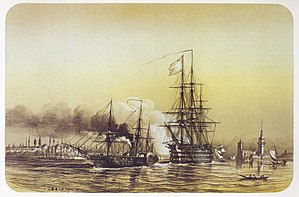French ship Friedland (1840)

The Friedland in tow of a steamer, after she ran aground near Constantinople
|
|
| History | |
|---|---|
|
|
|
| Name: | Friedland |
| Namesake: | Battle of Friedland |
| Builder: | Cherbourg |
| Laid down: | 1 May 1812 |
| Launched: | 4 March 1840 |
| Commissioned: | 5 October 1840 |
| Struck: | 31 December 1864 |
| General characteristics | |
| Class and type: | Océan class ship of the line |
| Displacement: | 5 302 tonnes |
| Length: | 65.18 m (213.8 ft) (196,6 French feet) |
| Beam: | 16.24 m (53.3 ft) (50 French feet) |
| Draught: | 8.12 m (26.6 ft) (25 French feet) |
| Propulsion: |
|
| Speed: | 10.6 knots (19.6 km/h; 12.2 mph) |
| Complement: | 1 079 men |
| Armament: |
|
| Armour: | Timber |
The Friedland was an Océan class 118-gun ship of the line of the French Navy.
Her keel was laid down in Cherbourg in 1812 as Inflexibe. During her construction, she was renamed Friedland, Duc de Bordeaux during the Bourbon Restoration, Friedland again briefly during the Hundred Days and back to Duc de Bordeaux thereafter. On 9 October 1830, following the July Revolution, she took her name of Friedland. She was finally launched on 4 March 1840.
She was decommissioned from 1852 to 1853, when she took back service and served in the Crimean war. In 1857, work was undertaken to convert her to a steam and sail ship, but the conversion was aborted in February 1858 and the engine was eventually installed on Turenne .
From March 1865, she was used as barracks hulk in Toulon, as Colosse.
...
Wikipedia
